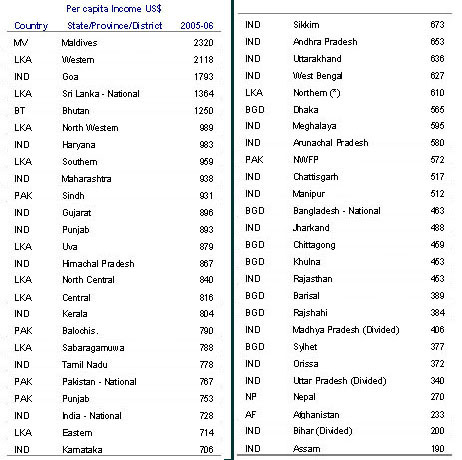
Ilankai Tamil Sangam
Association of Tamils of Sri Lanka in the USA
Published by Sangam.org
by Shanta, World Bank blog on South Asia, February 4, 2008
|
Parts of the subcontinent, such as the Maldives, the Western Province of Sri Lanka or some Indian states have already “eliminated” abject poverty (in the sense of having poverty rates below 10 percent). Other parts of South Asia such as Afghanistan or northern Sri Lanka are so mired in violent and escalating conflict that ending poverty seems a remote dream; providing basic security seems much more important. |

LKA = Sri Lanka
How is the quest to end poverty in South Asia going? Parts of the subcontinent, such as the Maldives, the Western Province of Sri Lanka or some Indian states have already “eliminated” abject poverty (in the sense of having poverty rates below 10 percent). Other parts of South Asia such as Afghanistan or northern Sri Lanka are so mired in violent and escalating conflict that ending poverty seems a remote dream; providing basic security seems much more important.
The reality is that South Asia is a heterogeneous region. The per capita income of the richest part is ten times that of the poorest part (see Table). Sustained economic growth and increasing globalization is propelling several Indian states, Bhutan, Maldives, and parts of Sri Lanka into middle-income environments.
A large part of South Asia is still low-income, with problems of persistent poverty, illiteracy and ill-health. And some 71 million South Asians live in conflict—either full-blown ones as in Sri Lanka and Afghanistan, or simmering ones in Balochistan and northeast India. What Shabana Azmi said of her homeland, “India is a country that lives in three centuries simultaneously,” applies to South Asia as well.
To end poverty in the subcontinent, we may need different strategies for each of these environments. For instance, in the middle-income states or countries, human development means improving the quality of education and health, whereas in the low-income regions, it is both access to and quality of education and health, and in the conflict areas, the challenge is to keep basic services functioning by whatever means possible—be they by NGOs, the private sector or community groups.
Is this differentiation useful? I look forward to your comments.
Freddie Bejamin says:
Wed, 02/06/2008 - I agree. However, I do believe that putting an end to conflict in the conflict zones of Srilanka, Nepal etc should be the major objective of any development plan. One of the big reasons for this is that conflict could spread into the other middle-income areas and undo the develpoment work.
© 1996-2025 Ilankai Tamil Sangam, USA, Inc.